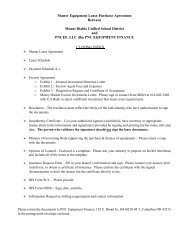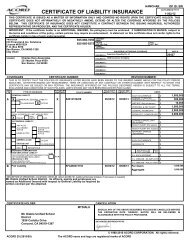Study of the Mount Diablo Unified School District - Mt. Diablo Unified ...
Study of the Mount Diablo Unified School District - Mt. Diablo Unified ...
Study of the Mount Diablo Unified School District - Mt. Diablo Unified ...
- No tags were found...
Create successful ePaper yourself
Turn your PDF publications into a flip-book with our unique Google optimized e-Paper software.
<strong>District</strong> Operations and Associated Financial Effectivenessdistrict cannot contract union work to vendors unless and until <strong>the</strong> Governor’sproposed changes for <strong>the</strong> 2010‐11 budget year are enacted by <strong>the</strong> Legislature.)• Adhere to special education services within natural feeder patterns to providespecial education services in <strong>the</strong> least restrictive environment, to <strong>the</strong> greatest extentpossible, thus decreasing transportation costs to <strong>the</strong> district.• Eliminate all special education transportation services that are not necessary as anIEP related service. This might include, but may not be limited to, transport to andfrom nonpublic placements for students and/or <strong>the</strong>ir parents or transportationto/from medically relevant <strong>the</strong>rapy.Cost Implications for Issue 2‐2:MDUSD should target a 10 percent savings rate for transportation expenditures. Based on2008‐09 actual expenditures, this would equate to a $350,000 savings annually. A five‐yearsavings would equate to $1,750,000.CONSIDERATION YEAR 1 YEAR 2 YEAR 3 YEAR 4 YEAR 5DecreaseTransportationExpenditures by10 Percent$350,000 $350,000 $350,000 $350,000 $350,000Issue 2‐3: Special Education Spending at <strong>the</strong> <strong>School</strong> Level.In discussions with central <strong>of</strong>fice special education and financial management staff as wellas school‐based staff, <strong>the</strong> review team found that school principals are not completelyaware <strong>of</strong> <strong>the</strong> amount <strong>of</strong> special education spending that occurs on <strong>the</strong>ir campuses. Inaddition, school‐based staff <strong>of</strong>ten are not fully informed <strong>of</strong> special education changes thatwill affect <strong>the</strong>ir campuses in regards to programs, staffing, classroom space, and design.One example <strong>of</strong> this is a new center program for autistic children implemented at YgnacioValley Elementary <strong>School</strong>. <strong>School</strong> staff were not aware <strong>of</strong> <strong>the</strong> new program until it wasready to be implemented at <strong>the</strong>ir school, and school staff do not have access to <strong>the</strong>budgetary and financial decisions or outcomes <strong>of</strong> <strong>the</strong> program. It appears that whendistrictwide special education programs are developed and implemented, schooladministrators have little input into <strong>the</strong> need, design, or location <strong>of</strong> <strong>the</strong> programs. Thelocation <strong>of</strong> program placement appears to be based primarily on where classroom space isavailable.A survey <strong>of</strong> central <strong>of</strong>fice and school‐based staff shows that cooperation and collaborationbetween <strong>the</strong> central <strong>of</strong>fice and school‐based staff could be improved, that communicationsrelated to financial and budget matters could be better, and that school‐based staff feel<strong>the</strong>y could be provided better information related to special education financial matters(Exhibit 2‐5). Complete survey results are found in Appendix A.MGT <strong>of</strong> America, Inc. Page 2‐7















